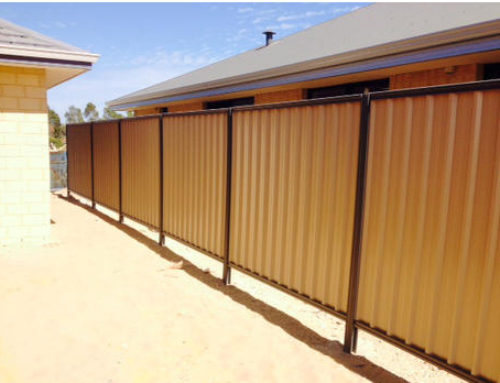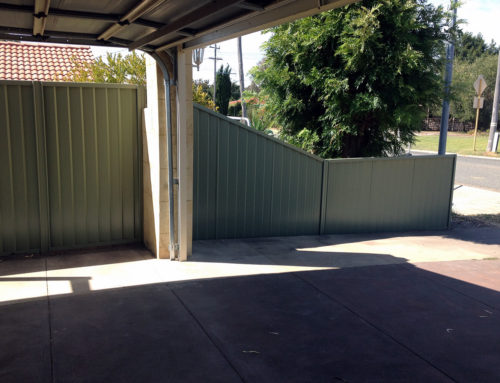So most of us are familiar with the two most common fencing types in Australia, but why one and not the other? What are we comparing?
Hardie fencing, also known as cement fibre or fibre cement sheet fencing, or Super 6 fencing, was designed by James Hardie to replace, and match, the old deadly asbestos fencing that we still see hanging around today. It’s installed by digging a trench, dropping the sheets in (the right way up and the right way around, as the waves kind of lock in together), and backfilling the trench on both sides. The aluminium capping helps keep the sheets together, and hides any small height variations and the little metal clips that are put on to hold the tops of the sheets to the next.
That’s kind of the short of it, but obviously it’s a bit more involved, with it being a heavy lifting, quite awkward job dropping those heavy sheets in the ground, straightening them with a string line, working with possibly uneven terrain.. here is a link with some pictures, in case you’re considering doing it yourself.
http://www.jameshardie.com.au/products/download/file/HardieFence+Install+Guide.pdf
Even when the ground looks flat, it may surprise you how much this isn’t an exact science, and although installing between properties, you may get away with one side being elevated slightly higher than the other, as unlike Colorbond, the additional earth thrown against it will not cause it to rust out due to the moisture in the soil, beware; Hardie fencing has not been designed to retain uneven soil levels; it works best when receiving equal amounts of soil pressure from both sides. Building up dirt unevenly on one side may cause the fence to lean over time.
So what are the benefits of Hardie?
- If it’s what you already have in, it will be cheaper to replace broken sections with more Hardie than the whole length with Colorbond.
- You can paint Hardie fencing any colour you like, but it may take a few coats if not properly prepared. It can match exactly to anything you like. Also, you can paint it a different colour on either side, so you don’t have to compromise or agree with your neighbour if it’s a common fence (shared fence, that is).
- Because it’s dug in to the ground 400-600mm all the way along, dogs can’t dig under it. and with no gaps underneath, nothing can get under (snakes, for example, if that’s an issue).
- If you’re planning on DIY-ing, the materials are cheaper than Colorbond fencing, and you won’t need much (mostly just a shovel, stakes and string line, level…)
- It looks the same on both sides.
- It can be cut to slope, after installing as a ‘stepped’ fence. So if you are installing to a sloped block, it can be installed first, then cut on the angle of the ground, then capped. Since the 2400mm sheets need to be burried 600mm into the ground, cutting the sheets down to accommodate a slope will reduce the height of your Hardie fence.
And the drawbacks?
- Hardie fences blow over in storms, Colorbond fences are far, far, far less likely to. For this reason, often your insurance company may encourage you to replace with Colorbond (as they won’t have to pay out on a storm damaged fence a second time).
- In ‘general opinion’, Colorbond fencing is more attractive, and more modern, than Hardie fencing.
- You can’t buy it painted, so many if not most people leave it that plain, grey (cement fibre) colour.
4. If you’re planning on having it professionally installed, Hardie MAY cost you more than Colorbond; obviously this is a debatable point. But Hardie fencing is very labour intensive, particularly if hand dug as it often is, even amongst professionals.
- It is near on impossible to install perfectly straight. The best you can hope for is for it to look straight to the eye; this is the case even when installed by professionals. Dropping those heavy sheets in to loose earth, awkwardly lifting them by the edges, each panel being about a metre wide, then holding them straight according to your string levels, while throwing dirt against them on either side. This doesn’t mean it can’t look straight, and doesn’t mean every Colorbond fence is perfectly straight either. In fact, drive around and look at the fences in your neighbourhood. There’s a good chance that unless you live in a newer area, that you might see more fences askew to varying degrees than straight down the line.
So what about Colorbond fencing then? Most people choose Colorbond over Hardie where they can. They aren’t installing Hardie fencing into new builds. Is it just for the look? Why no, no it is not, thanks for asking.
Colourbond fencing is manufactured from steel. Colorbond fencing goes together like a big Mechano set. Just like you have panels of Hardie fencing, you have panels of Colorbond fencing. But unlike the Hardie which is about 1100mm wide, Colorbond panels are usually more like 2.4metres wide (which can be made shorter by cutting rails and infill panels, and usually also available in longer panels also). The Colorbond panels are made up of a frame, and infill panels. So each panel has a top and bottom rail, side posts (which extend beyond the bottom rail so you can concrete them into the ground while the panel sits completely above ground), and there are three infill panels to make them easier to handle (rather than one 2.4metre infill panel). There are plenty of other bits and pieces for Colorbond fencing but I will cover that in another blog (such as steel posts, post caps, steel plinths, Colorbond fence toppers and extenders such as lattice and slats). See more information on Colorbond fencing here.
So lets start with the positives.
- Colorbond fencing DOES look nicer, and if you think differently, you’re in a small minority.
- It comes ready in a range of colours. Click here for colours.
- It’s installation method is far less labour intensive, but there are reasons why you should consider having it professionally installed. Instead of having to dig a trench, you need only dig holes where the posts will go in: at the ends of each panel.
- It’s stronger than Hardie fence as it is concreted in, not held in by earth. PLEASE NOTE: Although Colorbond fencing can be installed using quickset cement, it is not recommended. For a stronger fence, a mix should be made using roadbase or the like, for aggregation. Check what your installer will be using.
- Did I mention it looks better? I did? Well, as well as coming in a range of colours, you can mix it up, and use a different colour for your rails and posts than your infill panels. You also have the choice of different profiles, and different suppliers have different profiles. So you can choose a profile that looks the same on both sides, such as this zig zag profile by OXWORKS. (They’re in BRISBANE + MELBOURNE + PERTH + SYDNEY + ADELAIDE)
- You can install matching Colorbond gates. You could even match it to the exact colour of your Colorbond roof.
- It can be installed on top of limestone blocks, so if you have a limestone retaining wall on your boundary for example, it can be core drilled which is actually easier and less messy, possibly even cheaper. No dirt required!
So the cons?
- There are different manufacturers, so If you already have some Colorbond fencing you are wanting to match your profile to, you need to know who they are and purchase, or have your installer, purchase from them.
- It does not come with two different colours on two different sides (but then, neither does Hardie). You may be able to paint one side another colour, but then you will have to agree which neighbour has to do that (and be careful you’re doing it right, no-one likes paint runs on a Colorbond fence). Contact a painter for professional advice.
- It can dent. If you hit it with a ball hard enough, you may have to live with a dent.
- If it is being installed on a slope, you may have to choose between a stepped and a sloped installation. Stepped may be cheaper, but may also leave gaps under the fence on the lower end of each panel. The bigger the slope, the bigger the gaps. They may be minimal, and may not bother you at all mind. I’m not even sure if this is in fact, a con.
- It is not recommended you pile any dirt up against any part of the bottom rail or infill panels what-so-ever. The moisture sitting in the soil, were it to make contact with any minute scratches, could rust the fence.
So that’s it! Colorbond wins! But at least now you know why. It’s no more expensive, and it looks better, and it’s stronger.



